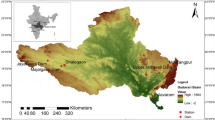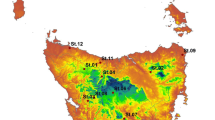Abstract
Multi-scale entropy (MSE) analysis was applied to the long-term (131 years) daily flow rates (Q) of the Mississippi River (MR) to investigate possible change in the complexity of the MR system due to human activities since 1940s. Unlike traditional entropy-based method that calculates entropy at only one single scale, the MSE analysis provided entropies over multiple time scales and thus accounts for multi-scale structures embedded in time series. It is found that the sample entropy (S E) for Q of the MR and its two components, overland flow (OF) and base flow (BF), generally increase as time scale increases. More importantly, it is found that there have been entropy decreases in Q, OF, and BF over large time scales. In other words, the MR may have been losing its complexity since 1940s. We explain that the possible loss in the complexity of the MR system may be due to the major changes in land use and land cover and soil conservation practices in the MR basin since 1940s.



Similar content being viewed by others
References
Billingsley P (1965) Ergodic theory and information. Wiley, New York
Costa M, Goldberger AL, Peng C-K (2002) Multiscale entropy analysis of complex physiologic time series. Phys Res Lett 89(6):068102
Costa M, Goldberger AL, Peng C-K (2005) Multiscale entropy analysis of biological signals. Phys Rev E 71
Demencio PA (1972) Concepts and models in groundwater hydrology. McGraw-Hill, New York
Donner S (2003) The impact of cropland cover on river nutrient levels in the Mississippi River Basin. Glob Ecol Biogeogr 12:341
Eckmann J-P, Ruelle D (1985) Ergodic theory of chaos and strange attractors. Rev Mod Phys 57:617
Gebert WA, Krug WR (1996) Stream flow trends in Wisconsin’s drift less area. Water Resour Bull 32:733
Grassberger P, Procaccia I (1983) Estimation of the Kolmogorov entropy from a chaotic signal. Phys Rev A 28:2591
Goldberger AL, Amaral LAN, Glass L, Hausdorff JM, Ivanov PCh, Mark RG, Mietus JE, Moody GB, Peng C-K, Stanley HE (2000) PhysioBank, PhysioToolkit, and PhysioNet: components of a new research resource for complex physiologic signals. Circulation 101(23):e215–e220 [Circulation Electronic Pages; http://www.circ.ahajournals.org/cgi/content/full/101/23/e215]
Goldberger AL, Peng C-K, Lipsitz LA (2002) Fractal dynamics in physiology: alterations with disease and aging. Neurobiol Aging 23:23
Hurst HE (1957) A suggested statistical model for some time series that occur in nature. Nature 180:494–495
Jackson LL (2002) Restoring prairie processes to farmlands. In: Jackson DL, Jackson LL (eds) The farm and natural habitat. Island Press, Washington
Johnson LC (1991) Soil conservation in Wisconsin: birth to rebirth. University of Wisconsin, Madison
Kramer LA, Burkart MA, Meek DW, Jaquis RJ, James DE (1999) Field-scale watershed evaluations in deep-loess soils: II. hydrologic responses to different agricultural land management systems. J Soil Water Conserv 54:705–710
Lake DE, Richman JS, Griffin MP, Moorman JR (2002) Sample entropy analysis of neonatal heart rate variability. Am J Physiol Regul Integr Comp Physiol 283:789–797
Lawrence AJ, Kottegota NT (1977) Stochastic modeling of river flow time series. J R Stat Soc Ser A 140(1):1–47
Li Z, Zhang Y-K (2007) Quantifying fractal dynamics of groundwater systems with detrended fluctuation analysis. J Hydrol 336(1–2):139–146
Livina V, Ashkenazy Y, Kizner Z, Strygin V, Bunde A, Halvin S (2003) A stochastic model of river discharge fluctuations. Physica A 330:283–290
Mandelbrot BB, Wallis JR (1969) Some long run properties of geophysical records. Water Resour Res 5:321–340
Matsoukas C, Islam S, Rodriguez-Iturbe I (2000) Detrended fluctuation analysis of rainfall and streamflow time series. J Geophys Res vol. 105, No.: D23, 29,165–29,172
Mays DC, Faybishenko BA, Finsterle S (2002) Information entropy to measure temporal and spatial complexity of unsaturated flow in heterogeneous media. Water Resour Res DOI:10.1029/2001WR001185
Ozkul S, Harmancioglu NB, Singh VP (2000) Entropy-based assessment of water quality monitoring networks. J Hydrol Eng 5(1):90–100
Peitgen HO, Saupe D, (eds) (1988) The science of fractal images. Springer, Heidelberg
Pincus SM (1991) Approximate entropy as a measure of system complexity. Proc Natl Acad Sci USA 88:2297
Pincus SM (2001) Assessing serial irregularity and its implications for health. Ann NY Acad Sci 954:245–267
Ramankutty N, Foley JA (1999) Estimating historical changes in global land cover: croplands from 1700 to 1992. Global Biogeochem Cycles 13:997
Richman JS, Moorman JR (2000) Physiological time-series analysis using approximate entropy and sample entropy. Am J Physiol Heart Circ Physiol 278:H2039–H2049
Schilling KE, Libra RD (2003) Increased base flow in Iowa over the second half of the 20th century. J Am Water Res Assoc 39:851
Shannon CE, Weaver W (1949) The mathematical theory of communication. University of Illinois Press, Urbana
Sloto RA, Crouse MY (1996) HYSEP: a computer program for stream flow hydrograph separation and analysis. US. Geological Survey Water-Resources Investigations Report 96–4040
Trimble SW and Lund SW (1982) Soil conservation and the reduction of erosion and sedimentation in the Coon Creek basin, Wisconsin. US. Geological Survey Professional Paper 1234
Zhang Y-C (1991) Complexity and 1/f noise: a phase space approach. J Phys I (Fr) 1:971–977
Zhang Y-K, Li Z (2005) Temporal scaling of hydraulic head fluctuations: non-stationary spectral analyses and numerical simulations. Water Resour Res. doi:10.1029/2004WR003797
Zhang Y-K, Li Z (2006) Effect of temporally correlated recharge on fluctuations of groundwater levels. Water Resour Res. doi:10.1029/2005WR004828
Zhang Y-K, Schilling K (2004) Temporal scaling of hydraulic head and river base flow and its implication for groundwater recharge. Water Resour Res. doi: 10.1029/2003WR002094
Zhang Y-K, Schilling K (2006) Increasing stream flow and base flow in Mississippi River since 1940’s: effect of land use change. J Hydrol. doi:10.1016/j.jhydrol.2005.09.033
Author information
Authors and Affiliations
Corresponding author
Rights and permissions
About this article
Cite this article
Li, Z., Zhang, YK. Multi-scale entropy analysis of Mississippi River flow. Stoch Environ Res Risk Assess 22, 507–512 (2008). https://doi.org/10.1007/s00477-007-0161-y
Published:
Issue Date:
DOI: https://doi.org/10.1007/s00477-007-0161-y




